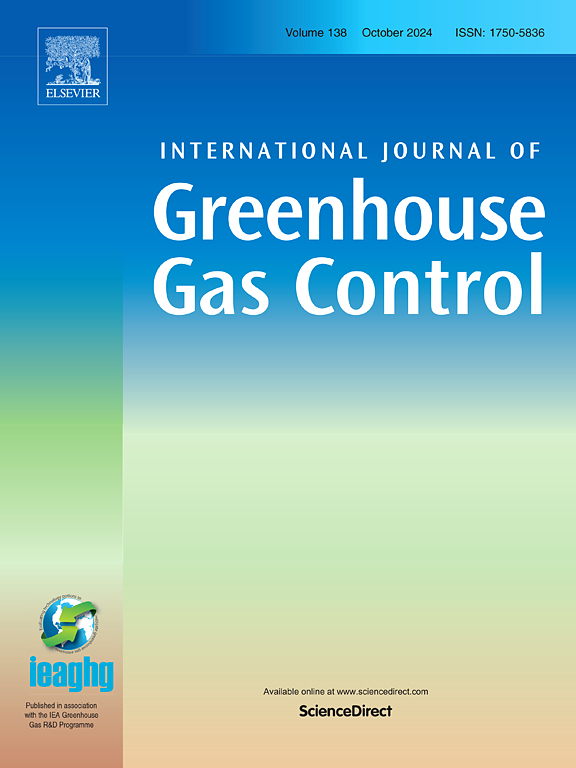Cost-effective carbon-dioxide removal through water electrolysis and Oxy-BECCS integration
IF 5.2
3区 工程技术
Q2 ENERGY & FUELS
International Journal of Greenhouse Gas Control
Pub Date : 2025-08-18
DOI:10.1016/j.ijggc.2025.104449
引用次数: 0
Abstract
This study investigates the integration of water electrolysis with biomass oxy-combustion and gasification for hydrogen (H₂) production and carbon dioxide removal (CDR) within a bioenergy with carbon capture and storage (BECCS) framework. As demand for clean H₂ grows to meet decarbonization goals, producing it with minimal emissions is increasingly critical. Oxygen (O₂) enhances combustion and gasification by reducing nitrogen dilution, improving thermal conversion efficiency, and facilitating CO₂ capture. Four configurations, atmospheric and pressurized combustion and gasification, are evaluated to assess the impact of process type and pressure on H₂ production, CO₂ capture, and electricity demand, highlighting trade-offs between conditions and costs.
All configurations achieve a net-negative emission system (Scope 1), with pressurized gasification delivering the lowest levelized cost of hydrogen (LCOH) at $3.91/kg H₂, a 21% reduction compared to the atmospheric combustion case, excluding CO₂ credits. Total capital investment (TCI) and cost of manufacturing (COM) are the lowest for combustion cases due to their simpler process design, requiring fewer equipment units and lower net electricity demand. Conversely, gasification configurations require syngas processing and compression, leading to higher capital and operating costs, however, these are offset by the near doubling of H2 production. Sensitivity analysis reveals that CO₂ credits of up to $117 USD/tonne can reduce LCOH below standalone electrolysis. Additionally, electrolyzer-integrated O₂ consistently outperforms air separation unit (ASU)-sourced O₂ in cost-effectiveness across scenarios, highlighting the economic value of CO₂ credits in supporting net-negative H2 pathways. Pressurized gasification is identified as the most cost-effective overall, while combustion is better suited to electricity- or capital-constrained applications.
通过水电解和氧- beccs集成具有成本效益的二氧化碳去除
本研究探讨了在生物能源与碳捕获和储存(BECCS)框架内,将水电解与生物质氧燃烧和气化相结合,用于氢(H₂)生产和二氧化碳去除(CDR)。为了实现脱碳目标,对清洁氢的需求不断增长,以最小的排放生产氢变得越来越重要。氧(O₂)通过减少氮的稀释、提高热转换效率和促进CO₂捕获来促进燃烧和气化。评估了四种配置,即常压燃烧和加压燃烧和气化,以评估工艺类型和压力对H₂产生,CO₂捕获和电力需求的影响,突出了条件和成本之间的权衡。所有配置都实现了净负排放系统(范围1),加压气化提供了最低的氢(LCOH)平均成本,为3.91美元/千克H 2,与大气燃烧情况相比减少了21%,不包括CO₂信用额。燃烧工况的总资本投资(TCI)和制造成本(COM)是最低的,因为它们的工艺设计更简单,需要更少的设备单元和更低的净电力需求。相反,气化配置需要合成气处理和压缩,从而导致更高的资本和运营成本,然而,这些成本被氢气产量几乎翻倍所抵消。敏感性分析显示,高达117美元/吨的二氧化碳信用额度可以将LCOH降低到低于独立电解的水平。此外,在各种情况下,电解槽集成的O₂在成本效益方面始终优于空气分离装置(ASU)来源的O₂,突出了CO₂信用额度在支持净负H2途径方面的经济价值。总的来说,加压气化被认为是最具成本效益的,而燃烧更适合电力或资本有限的应用。
本文章由计算机程序翻译,如有差异,请以英文原文为准。
求助全文
约1分钟内获得全文
求助全文
来源期刊
CiteScore
9.20
自引率
10.30%
发文量
199
审稿时长
4.8 months
期刊介绍:
The International Journal of Greenhouse Gas Control is a peer reviewed journal focusing on scientific and engineering developments in greenhouse gas control through capture and storage at large stationary emitters in the power sector and in other major resource, manufacturing and production industries. The Journal covers all greenhouse gas emissions within the power and industrial sectors, and comprises both technical and non-technical related literature in one volume. Original research, review and comments papers are included.

 求助内容:
求助内容: 应助结果提醒方式:
应助结果提醒方式:


